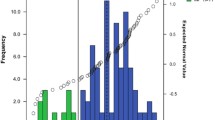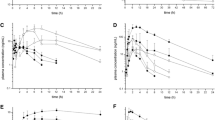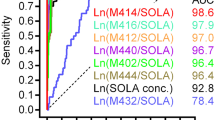Abstract
Objectives
The hypoglycaemic drug tolbutamide is used for assessment of CYP2C9 activity in vivo. However, therapeutically active doses of 500 mg bear the risk of hypoglycaemia, and a tolbutamide-derived parameter based on a single plasma or urine concentration reflecting CYP2C9 activity accurately is lacking.
Methods
We examined tolbutamide and its metabolites 4′-hydroxy-tolbutamide and carboxytolbutamide in plasma and urine of 26 healthy, male volunteers up to 24 h after intake of 125 mg tolbutamide using liquid chromatography–tandem mass spectrometry. CYP2C9 genotypes were determined by sequencing of exons 3 and 7. Raw plasma and urine data were compared with pharmacokinetic parameters, CYP2C9 genotypes, and data from a study in 23 volunteers with all six CYP2C9*1–*3 combinations who received 500 mg tolbutamide.
Results
Plasma clearance and tolbutamide plasma concentrations 24 h after drug intake reflected the genotypes: 0.85 l/h and 1.70 µg/ml (95% confidence interval, CI, 0.80–0.89 l/h and 1.50–1.90 µg/ml) for CYP2C9*1 homozygotes (n=15), 0.77 l/h and 2.14 µg/ml (95%CI, 0.67–0.88 l/h and 1.64–2.63 µg/ml) for *1/*2 genotypes (n=7), 0.60 l/h and 3.13 µg/ml (95%CI, 0.58–0.62 l/h and 2.68–3.58 µg/ml) for *1/*3 genotypes (n=3), and 0.57 l/h and 3.27 µg/ml in the single *2/*2 carrier. Natural logarithms of tolbutamide plasma concentrations 24 h after intake correlated to plasma clearance (r2=0.84, P<0.0000001). This correlation was confirmed in the comparison data set (r2=0.97, P<0.0000001).
Conclusions
A low dose of 125 mg tolbutamide can safely and accurately be used for CYP2C9 phenotyping. As a simple metric for CYP2C9 activity, we propose to determine tolbutamide in plasma 24 h after drug intake.




Similar content being viewed by others
References
Miners JO, Birkett DJ (1998) Cytochrome P4502C9: an enzyme of major importance in human drug metabolism. Br J Clin Pharmacol 45:525–538
Streetman DS, Bertino JS Jr, Nafziger AN (2000) Phenotyping of drug-metabolizing enzymes in adults: a review of in-vivo cytochrome P450 phenotyping probes. Pharmacogenetics 10:187–216
Lee CR, Goldstein JA, Pieper JA (2002) Cytochrome P450 2C9 polymorphisms: a comprehensive review of the in-vitro and human data. Pharmacogenetics 12:251–263
Relling MV, Aoyama T, Gonzalez FJ, Meyer UA (1990) Tolbutamide and mephenytoin hydroxylation by human cytochrome P450s in the CYP2C subfamily. J Pharmacol Exp Ther 252:442–447
Veronese ME, Mackenzie PI, Doecke CJ, McManus ME, Miners JO, Birkett DJ (1991) Tolbutamide and phenytoin hydroxylations by cDNA-expressed human liver cytochrome P4502C9. Biochem Biophys Res Commun 175:1112–1118 (Erratum 180:1527)
Srivastava PK, Yun CH, Beaune PH, Ged C, Guengerich FP (1991) Separation of human liver microsomal tolbutamide hydroxylase and (S)-mephenytoin 4’-hydroxylase cytochrome P-450 enzymes. Mol Pharmacol 40:69–79
Wester MR, Lasker JM, Johnson EF, Raucy JL (2000) CYP2C19 participates in tolbutamide hydroxylation by human liver microsomes. Drug Metab Dispos 28:354–359
Kirchheiner J, Bauer S, Meineke I, Rohde W, Prang V, Meisel C, Roots I, Brockmöller J (2002) Impact of CYP2C9 and CYP2C19 polymorphisms on tolbutamide kinetics and the insulin and glucose response in healthy volunteers. Pharmacogenetics 12:101–109
Shon JH, Yoon YR, Kim KA, Lim YC, Lee KJ, Park JY, Cha IJ, Flockhart DA, Shin JG (2002) Effects of CYP2C19 and CYP2C9 genetic polymorphisms on the disposition of and blood glucose-lowering response to tolbutamide in humans. Pharmacogenetics 12:111–119
Veronese ME, Miners JO, Randles D, Gregov D, Birkett DJ (1990) Validation of the tolbutamide metabolic ratio for population screening with use of sulfaphenazole to produce model phenotypic poor metabolizers. Clin Pharmacol Ther 47:403–411
Veronese ME, Miners JO, Rees DLP, Birkett DJ (1993) Tolbutamide hydroxylation in humans: lack of bimodality in 106 healthy subjects. Pharmacogenetics 3:86–93
Lee CR, Pieper JA, Hinderliter AL, Blaisdell JA, Goldstein JA (2002) Evaluation of cytochrome P4502C9 metabolic activity with tolbutamide in CYP2C9*1 heterozygotes. Clin Pharmacol Ther 72:562–571
Gründemann D, Schömig E (1996) Protection of DNA during preparative agarose gel electrophoresis against damage induced by ultraviolet light. Biotechniques 21:898–903
Lee CR, Pieper JA, Frye RF, Hinderliter AL, Blaisdell JA, Goldstein JA (2003) Tolbutamide, flurbiprofen, and losartan as probes of CYP2C9 activity in humans. J Clin Pharmacol 43:84–91
Damkier P, Brøsen K (2000) Quinidine as a probe for CYP3A4 activity: intrasubject variability and lack of correlation with probe-based assays for CYP1A2, CYP2C9, CYP2C19, and CYP2D6. Clin Pharmacol Ther 68:199–209
Rostami-Hodjegan A, Nurminen S, Jackson PR, Tucker GT (1996) Caffeine urinary metabolite ratios as markers of enzyme activity: a theoretical assessment. Pharmacogenetics 6:121–149
Acknowledgements
We like to express our thanks to Hendrik Lück and Dirk Kroll for the excellent study organisation and to Anke Rattay for skilful technical assistance. Grants of Bayer AG, Wuppertal, Germany, and Novartis, Basel, Switzerland, were obtained for parts of the study A.
Author information
Authors and Affiliations
Corresponding author
Rights and permissions
About this article
Cite this article
Jetter, A., Kinzig-Schippers, M., Skott, A. et al. Cytochrome P 450 2C9 phenotyping using low-dose tolbutamide. Eur J Clin Pharmacol 60, 165–171 (2004). https://doi.org/10.1007/s00228-004-0754-z
Received:
Accepted:
Published:
Issue Date:
DOI: https://doi.org/10.1007/s00228-004-0754-z




